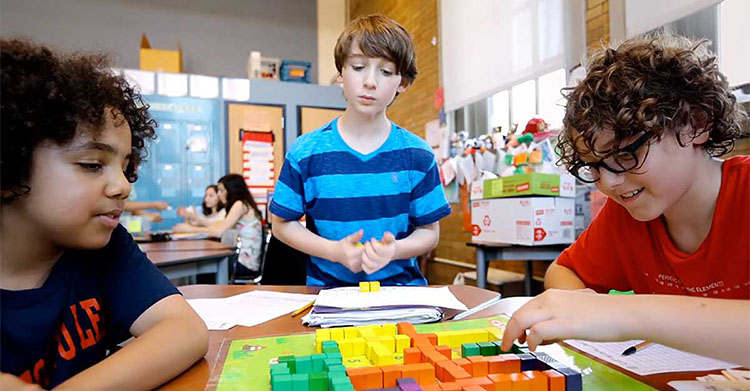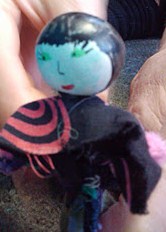Fun leads to mastery in game-based education
/Some of the most innovative, forward-looking alternative learning experiences for kids today are built on the notion of games and gaming. Edutopia, the teaching and learning website, even has a Pinterest board devoted to game-based learning. Many commercial games that teach biology, math, history, geography, and every other subject imaginable are infiltrating traditional classrooms, and for particular subjects or problems, that makes a lot of sense. But for this blog post, I wanted to look at why educators would create an entire curriculum based on gaming.
Thinking hard, gaming hard at Quest to Learn, an alternative public school in New York City
In New York City an innovative school for grades 6–12 called Quest to Learn is an evolving project to improve kids’ learning, empathy, and collaboration skills. In reading about Quest, I learned the basic tenets of the gaming approach—and then I was lucky enough to interview Austin’s own Cheryl Kruckeberg, who has been advocating for game-based education and running Game of Village, a program based on these tenets, for years.
Quest’s founders, a nonprofit group called the Institute of Play, created an alternative, publicly funded “school of choice” entirely focused on games for a few key reasons, including:
- Games ask us to collaborate with others and learn by doing.
- In a game, teachers and students can see immediately whether they are succeeding or failing and can go back and try again, or “iterate.” Failing is an important part of learning in any game, and (unlike a failing grade in a traditional classroom) helps motivate kids to keep trying.
- Learning happens by doing!
- Everyone gets to participate and contribute something unique to the process.
- Feedback happens in the moment, not days or weeks later in an exam.
A long-running Austin program centered on interdisciplinary learning through role playing and world building
My talk with Austin’s Cheryl Kruckeberg reinforced many of the notions above with real-life examples from Game of Village. Cheryl says that one of the best things about learning through play is that the consequences aren’t dire, so kids can go all out to win, but if they lose or make mistakes, it’s just a game. “Tomorrow they come back and try again.”
The problem in most grade-based education, says Cheryl, is that it tells kids that an “F” is a statement about who they are, and that may very well change how they think about themselves. “All of that judgment is gone in the concept of the game,” she explains. Kids are having fun and working together to improve, not anxious about judgment and evaluations from others.
“Play is the modus operandi of learning—the way to knowledge, to intimacy, to relationships with the world and people in it,” Cheryl continues. “Jean Piaget [the pioneering child psychologist] said that play is for the pleasure of mastery, and I think that’s right. Kids will do things for play and bend themselves into pretzels to overcome any challenge for the sheer pleasure of mastering something—to get to the next level in a digital game or board game, for example—when they wouldn’t do that for the sake of rote classroom learning.”
Readers of the blog may have met Cheryl a few months ago, when she wrote a blog post about exactly how Game of Village works—creating an entire alternative village-world on a 1/24 scale, with 3-inch avatars, or “peeps” who inhabit the village. Games ideally last about 25–30 days and include around 25 kids, but the time period can span an intensive five or six weeks, or can be spread out over an entire school year for one day each week.
From a recent Game of Village showcase
I wondered what kind of learning objectives and structures the Game of Village mentors begin with, and Cheryl explained, “What we do is set some basic take-aways and usually a time period and geographical setting. It’s important to have some parameters, so that kids have something to push against. From there, they have a lot of freedom to explore.”
“Recently, we launched a village of the future, which kids love because of all the gizmos they can try. Our goals were to talk about sustainability and climate, including exploring sustainable living systems. The kids got an invitation to help the inhabitants of a distant planet that had used up all its resources. They had to build a model sustainable village and educate the aliens on how to use it. The kids had to research carbon footprints, carbon capture, how to produce electricity through solar, wind, and wave technology versus fossil fuels—explaining their impacts and long-term viability. They designed homes and civic systems. It’s exciting because the way each village evolves is organic, and the mentors release control of the game to the kids as soon as possible.”
A Game of Village participant tinkering toward mastery
Often the kids in Game of Village are of a similar age—around 10 to 14, but sometimes there are 8-year-olds, and those kids find unique ways of playing the game, says Cheryl. “The older kids get into the heady stuff and deep research, but younger kids do more of the crafting.” Just as in real life, both thinkers and crafters are critical to success.
Cheryl also believes that interactions between the students are invaluable in teaching students about nurturing and supporting each other. “We have kids who begin at a young age and then move into leadership roles as they get older. There are times when something the little ones need to do is a task they can’t handle, so we have older kids who are ‘village mentors in training’ and do safety training that allows them to help younger kids and reinforce their own learning at the same time. Our traditional schools separate kids so much that this important mentoring time is gone, and that’s a huge loss in our society. The Game of Village tries to avoid that separation. Kids need the opportunity to nurture.”
“For me, somewhere along the line education got separated from learning,” Cheryl explains. “People really want to learn, and that distinguishes us as a species. Sparrows will just build nests the same way, over and over—but human beings want to try this, that, and the other thing, always trying new alternatives.” In a nutshell—or an eggshell—this is what game-based learning provides.
Pacifica Village
Game of Village kids completed their creation of Pacifica, a sustainable village for the planet Kepler-9D, on May 19 at AHB Community School. Students at Integrity Academy will experience a full unit of Game of Village next year. More information about Game of Village and how your kids can get involved is available here.
And for another fascinating take on role-playing games and learning, check out a recent article by Paul Darvasi for KQED News, about Sword and Sorcery Camps.
Game on!
Shelley Sperry






















